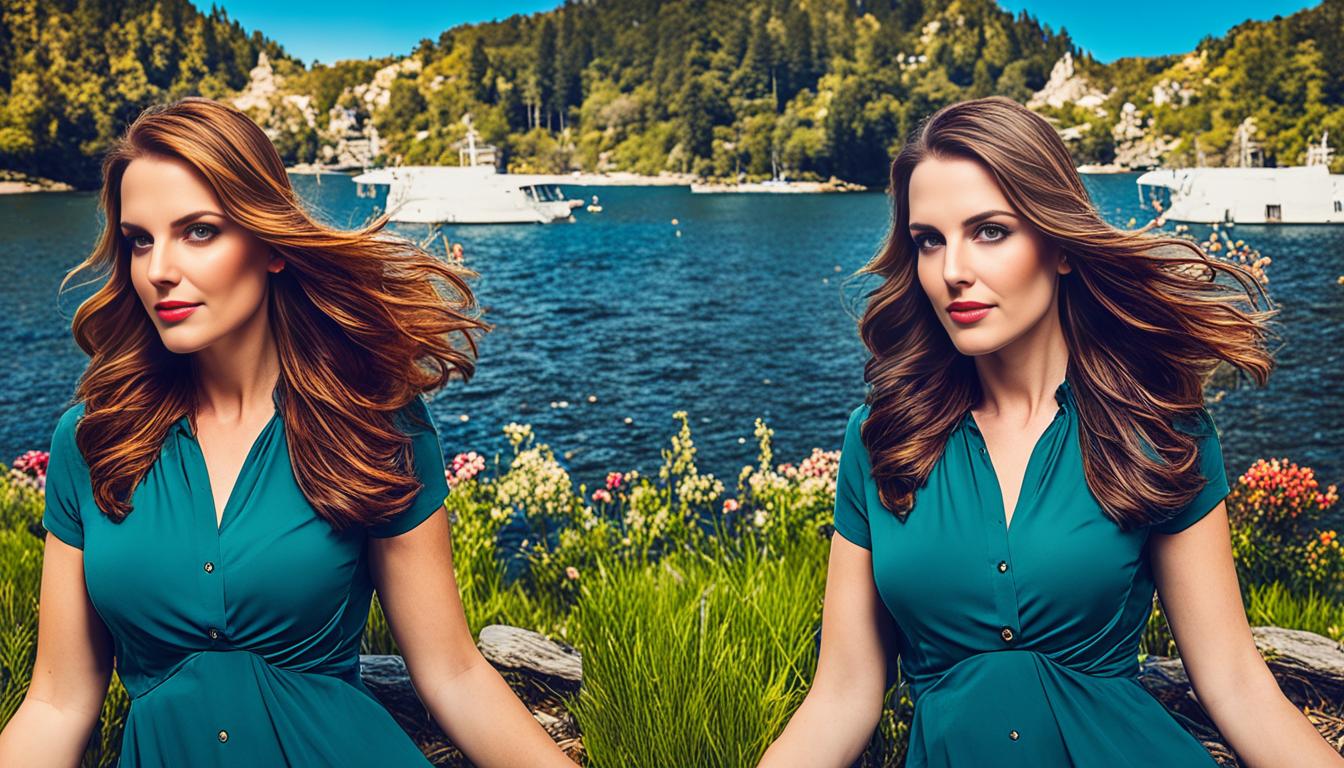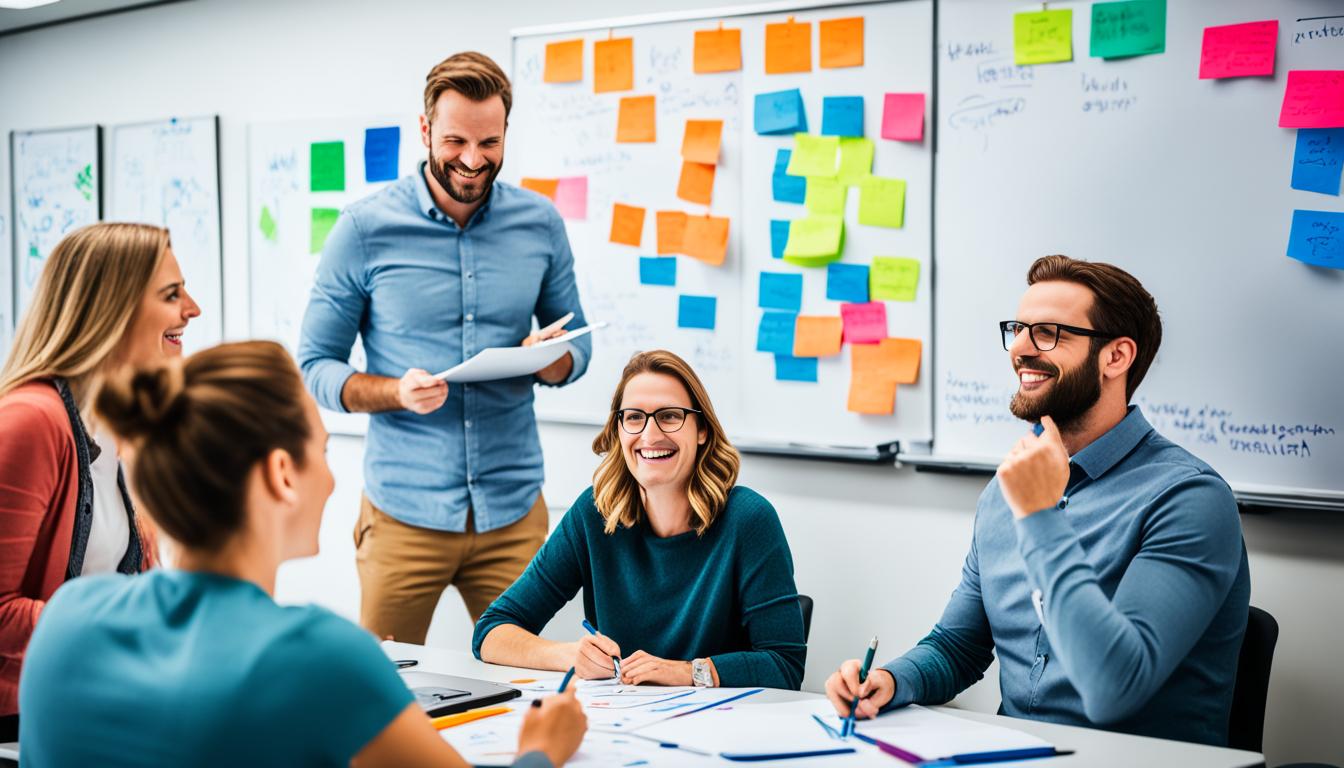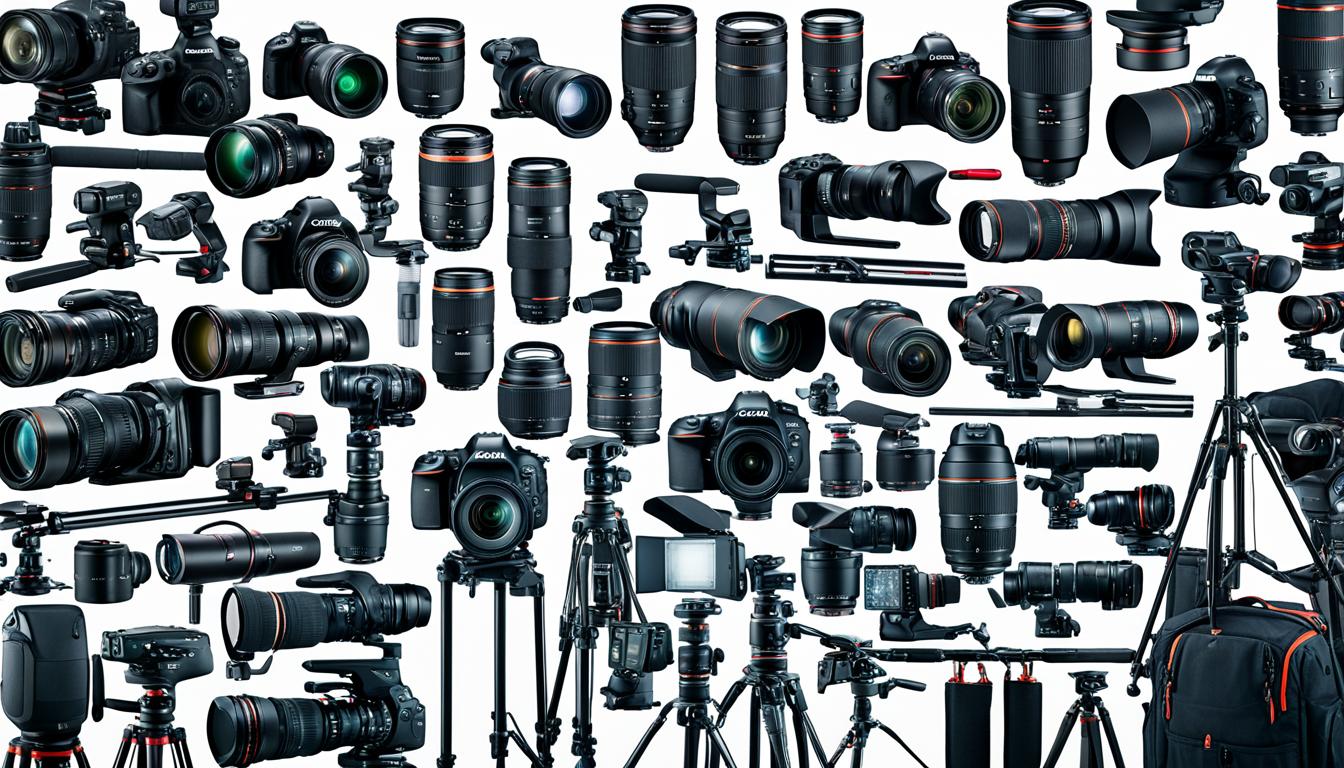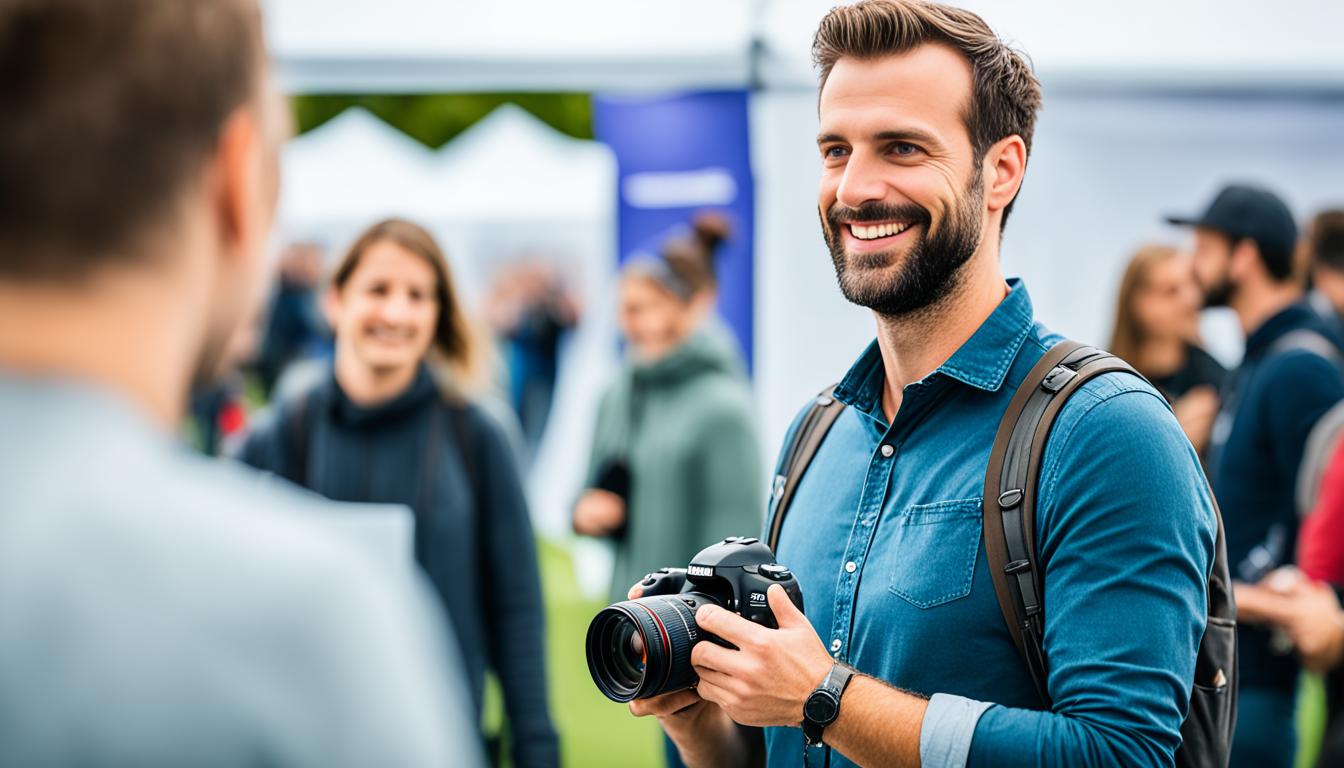Event photography is a captivating art that allows us to capture the essence of special moments, creating lasting memories for our clients. To truly excel in this craft, we must not only be skilled behind the camera but also possess a solid understanding of post-processing techniques. In this article, we will explore the best post-production practices and event photography editing techniques that will take our images to the next level.
Key Takeaways:
- Preparation is key: Communicate with event organizers, create a shot list, and scout the venue beforehand.
- Master your camera settings: Choose the right equipment, understand shooting modes, and adjust exposure and focus settings.
- Create compelling compositions: Use the rule of thirds, experiment with angles, and incorporate foreground and background elements.
- Master lighting techniques: Understand natural and artificial light, adapt to different lighting conditions, and manage color temperature.
- Build rapport with your subjects: Engage in conversation, give clear instructions, and capture genuine emotions.
Pre-Event Preparation
Pre-event preparation is the cornerstone of successful event photography. To ensure we capture every cherished moment, we prioritize meticulous planning and thorough organization. By immersing ourselves in the event’s purpose and theme, we develop a clear vision of the shots we want to capture.
Understanding the Event
Effective pre-event preparation begins with a comprehensive understanding of the event’s purpose and theme. We engage in open communication with event organizers and clients, asking relevant questions to gain insights into their expectations. By aligning ourselves with their vision, we can deliver photographs that truly reflect the essence of the event.
Creating a Shot List and Timeline
A well-curated shot list guides us through the event and ensures we capture all the key moments. We work closely with our clients to create a customized shot list that encompasses their specific needs and desires. This allows us to capture important milestones, candid interactions, and the unique details that make each event special. Additionally, we develop a detailed timeline to ensure a seamless flow of photography coverage throughout the event.
Ensuring Equipment Readiness
Our commitment to excellence means our photography equipment is always in top shape. We conduct thorough equipment checks prior to each event, ensuring that cameras, lenses, flashes, and other accessories are clean and fully functional. By being well-prepared and equipped, we can focus on capturing exceptional images without any technical hindrances.
Scouting the Event Venue
Scouting the event venue ahead of time allows us to familiarize ourselves with the space and identify optimal shooting locations. By exploring the venue, we can identify areas with the best lighting conditions, potential challenges to overcome, and unique backdrops that will enhance the photographs. This allows for efficient planning and ensures we can seamlessly navigate the venue on the day of the event.
Pre-event preparation is the foundation of successful event photography. Through a comprehensive understanding of the event, creating a shot list and timeline, ensuring equipment readiness, and meticulously scouting the venue, we set the stage for capturing extraordinary moments that will be cherished for a lifetime.
Mastering Camera Settings
To capture high-quality images as event photographers, it is crucial for us to master camera settings. The right camera and lenses, understanding shooting modes, and adjustments to ISO, shutter speed, and aperture are all factors that contribute to the perfect exposure. We also need to pay attention to white balance, focus settings, exposure compensation, and drive mode selection for optimal results.
When it comes to choosing the right camera and lenses for event photography, we need to consider the type of events we will be covering and the desired outcome. Investing in a camera with a fast autofocus system and high ISO capabilities can greatly enhance our ability to capture sharp and well-exposed images in challenging lighting conditions.
Understanding shooting modes is essential to adapt to different shooting scenarios. The Manual mode gives us full control over all camera settings, allowing us to fine-tune our exposure. The Aperture Priority and Shutter Priority modes are ideal when we want to prioritize depth of field or freezing motion, respectively. The Program mode offers a balance between control and convenience, while Auto mode can be helpful in fast-paced situations when we need to rely on the camera’s automatic settings.
ISO, shutter speed, and aperture are the three pillars of exposure control. ISO determines the camera’s sensitivity to light, with higher ISO values being more suited for low-light environments. Shutter speed determines the length of time the camera’s sensor is exposed to light, allowing us to freeze or blur motion. Aperture controls the amount of light entering the camera and affects the depth of field, which is important for controlling the focus and background blur in our images.
Setting the white balance correctly is crucial in ensuring accurate color reproduction. While auto white balance usually does a decent job, manually adjusting it based on the lighting conditions can yield more reliable results.
Focus settings are crucial to capturing sharp images. Depending on the situation, we can choose between single-point autofocus for precise focus control or continuous autofocus for tracking moving subjects. Utilizing back-button focus can also help separate focus control from the shutter button for greater flexibility.
Exposure compensation allows us to override the camera’s automatic exposure settings, ensuring proper exposure even in challenging lighting situations. By adjusting the exposure value, we can make our images brighter or darker to achieve the desired result.
Drive mode selection determines how the camera captures multiple shots in succession. This is particularly useful for events with fast-paced moments, such as capturing multiple shots during a dance performance or group shots where we want to ensure everyone’s eyes are open. Options such as single shot, continuous shooting, and self-timer give us the flexibility to capture the perfect moments.
Camera Settings Overview
| Setting | Description |
|---|---|
| Camera and Lenses | Choose the appropriate camera and lenses for event photography, considering the event type and desired outcome. |
| Shooting Modes | Understand and utilize different shooting modes such as Manual, Aperture Priority, Shutter Priority, Program, and Auto, depending on the shooting scenario. |
| ISO, Shutter Speed, and Aperture | Adjust ISO, shutter speed, and aperture settings to control exposure and capture the desired effects. |
| White Balance | Set the appropriate white balance to ensure accurate color reproduction in different lighting conditions. |
| Focus Settings | Master focus settings, including single-point autofocus, continuous autofocus, and back-button focus, to capture sharp images. |
| Exposure Compensation | Override the camera’s automatic exposure settings with exposure compensation to ensure proper exposure in challenging lighting situations. |
| Drive Mode | Select the appropriate drive mode for capturing multiple shots in succession, depending on the event’s pace and requirements. |
Composition and Framing
Composition and framing are essential elements in event photography that can elevate your images from ordinary to extraordinary. By applying techniques such as the rule of thirds, capturing unique angles and perspectives, and incorporating foreground and background elements, you can create visually stunning photographs that capture the true essence of the event.
The rule of thirds is a fundamental principle in composition that divides the frame into three vertical and horizontal sections. By placing key elements along these lines or at their intersections, you can create a sense of balance and visual interest.

“Using the rule of thirds, I was able to capture a striking moment between the bride and groom during their first dance. The placement of their faces at the intersection points adds a dynamic element to the composition, drawing the viewer’s eye directly to the couple.”
Furthermore, exploring unique angles and perspectives can provide a fresh and captivating viewpoint. Look for vantage points that offer a different view from the usual eye level, whether it’s shooting from above or getting down low to the ground. This adds depth and dimension to your images, making them more visually engaging.
Incorporating foreground and background elements is another effective technique for composition and framing. By including objects or people in the foreground, you can create a sense of depth and context. This adds layers to your image, making it more visually dynamic. Similarly, paying attention to the background and ensuring it complements the subject helps create a cohesive and visually pleasing composition.
Composition and Framing Tips:
- Experiment with the rule of thirds to create balanced compositions.
- Explore different angles and perspectives to add interest to your images.
- Incorporate foreground and background elements for depth and context.
By mastering composition and framing techniques, you can capture authentic moments and emotions that tell a compelling story through your event photographs.
Lighting Techniques
To capture captivating and memorable images, event photographers must master the art of lighting. Understanding natural and artificial light sources, adapting to different lighting conditions, using flash and external lighting strategically, and managing color temperature are essential skills in this field.
Understanding Natural and Artificial Light
Event photographers should familiarize themselves with the characteristics of both natural and artificial light sources. Natural light, such as sunlight, provides a soft and warm glow, whereas artificial light can vary in intensity and color temperature.
Adapting to Different Lighting Conditions
Events can take place in various lighting conditions, from bright outdoor settings to dimly lit indoor venues. Event photographers need to adjust their camera settings and equipment to ensure optimal exposure and capture the atmosphere of the event.
Strategically Using Flash and External Lighting
Flash and external lighting can be powerful tools in event photography. By strategically placing and modifying the position of these light sources, photographers can enhance the subject’s features, add depth to the images, and create a more dramatic effect.
Managing Color Temperature
Color temperature refers to the warmth or coolness of light. Different light sources emit light with varying color temperatures, which can affect the overall color balance in photographs. By understanding and managing color temperature, event photographers ensure accurate color reproduction for more visually pleasing images.
Mastering lighting techniques is an essential skill that enables event photographers to create captivating and memorable images. By understanding natural and artificial light, adapting to different lighting conditions, strategically using flash and external lighting, and managing color temperature, photographers can capture the essence of every event.
Interacting with Subjects
In event photography, the ability to interact with subjects is key to capturing authentic and compelling images. Interacting with subjects involves building rapport, giving clear instructions, and capturing genuine emotions. It requires patience, sensitivity, and the ability to make subjects feel comfortable in front of the camera.
Building rapport is the foundation of successful subject interaction. It allows us to establish a connection with our subjects, putting them at ease and creating a relaxed environment for photography. By engaging in conversation and taking a genuine interest in their stories, we can build trust and capture their true essence.
When taking group shots or posing subjects for portraits, giving clear instructions is crucial. Clear instructions help ensure that everyone understands their role and knows how to position themselves. This leads to well-composed and organized group shots that reflect the desired atmosphere of the event.
To capture genuine emotions, we must be observant and patient. This involves being attuned to the interactions and dynamics among individuals, waiting for the perfect moment to click the shutter. Candid moments often reveal an unfiltered display of emotions, adding an authentic touch to our photographs.
Being unobtrusive during candid moments is essential. We want our subjects to forget about the camera’s presence, allowing us to capture their natural expressions and reactions. By blending into the background and respecting personal boundaries, we can capture genuine and uninhibited moments that resonate with viewers.
It’s also essential to show sensitivity to shy or reserved subjects. They may feel uncomfortable in front of the camera, making it challenging to capture their true personalities. By creating a supportive and non-judgmental environment, we can help them feel more at ease, resulting in photographs that truly reflect who they are.
Interacting with subjects is an art in itself. It requires a blend of technical skills and interpersonal abilities. When combined effectively, these interactions result in photographs that capture the true essence of the event and resonate with viewers long after the moment has passed.

| Key Tips for Interacting with Subjects |
|---|
| Build rapport by engaging in conversation and showing genuine interest in subjects. |
| Give clear instructions for group shots or posed portraits to ensure everyone understands their role. |
| Be patient and observant to capture genuine emotions and candid moments. |
| Be unobtrusive during candid moments to capture authentic and uninhibited expressions. |
| Show sensitivity to shy or reserved subjects, creating a supportive environment to help them feel at ease. |
Post-Event Workflow
Once the event is over and you have captured the moments, it’s time to dive into the post-event workflow. This is where we transform raw captures into polished, memorable photographs that will delight our clients.
Let’s walk through the key steps involved in this process:
Import and Organization
The first step is to import the images from your camera to your computer. Ensure that you have a structured folder system in place to organize the photos effectively. By organizing your images based on event name, date, and location, you’ll have no trouble finding specific shots later on.
Selection
The next step is selecting the best shots for editing. As photographers, we often capture multiple frames of the same scene or moment. It’s important to review each image and choose the ones that best represent the event and tell the desired story. Be selective and aim for quality over quantity.
Editing
This is where the magic happens. Editing allows us to enhance the images and bring out their full potential. Adjusting exposure, color balance, and contrast can significantly improve the overall look and feel of the photos. Additionally, retouching as needed can help remove distractions and ensure a polished final result.
Preservation
Preserving high-resolution images is crucial for long-term storage and future use. Make sure to create backups of your edited photos and store them in a secure location, such as an external hard drive or cloud storage. This ensures that your work is protected and readily accessible whenever needed.
Delivery
Finally, it’s time to deliver the final photos to your clients. Discuss the preferred format and method of delivery with your clients beforehand, whether it’s through a password-protected online gallery, USB drive, or printed albums. Ensuring a smooth and timely delivery will leave a lasting positive impression on your clients.
“The post-event workflow is a crucial part of event photography. It allows us to refine our captures and deliver exceptional results to our clients.”
By following a systematic post-event workflow, we can streamline our editing process, produce consistent results, and exceed client expectations. Remember, each event is unique, requiring a personalized touch to capture its essence and preserve it for years to come.
| Post-Event Workflow | Benefits |
|---|---|
| Import and Organization | Efficient management of event photos |
| Selection | Choose the best shots for editing |
| Editing | Enhancement and refining of images |
| Preservation | Long-term storage and protection of photos |
| Delivery | Satisfying client requests and preferences |
Mastering the post-event workflow is essential for event photographers, as it ensures that our clients receive stunning images that capture the essence of their special moments. With careful import and organization, thoughtful selection, skillful editing, reliable preservation, and prompt delivery, we can truly elevate our event photography to new heights.
Business and Marketing Tips
Success in event photography goes beyond capturing great shots. Effective business and marketing strategies are equally crucial. At [Your Photography Business Name], we understand the importance of building a strong brand identity, pricing and packaging our services, seeking client feedback, networking within the event industry, and collaborating with event planners to expand our client base.
Building a Strong Brand Identity
A strong brand identity is the cornerstone of a successful event photography business. We believe in showcasing our unique style, values, and expertise to stand out from the competition. By consistently delivering high-quality images and exceeding client expectations, we have been able to establish a strong reputation in the industry.
Pricing and Packaging
Pricing our services competitively is vital for attracting clients while ensuring profitability. We offer packages tailored to different event types and budgets to accommodate a wide range of clients. Our transparent pricing structure and clear package details help clients understand the value they receive, building trust and encouraging bookings.
Client Feedback
Client feedback plays a crucial role in our continuous improvement. We actively seek feedback from clients after each event to understand their experience and identify areas where we can enhance our services. By listening to our clients’ needs and incorporating their input, we foster long-term relationships and maintain a strong reputation for customer satisfaction.
Networking
Networking within the event industry is essential for creating meaningful connections and generating referrals. We attend industry conferences, join professional associations, and actively engage with event planners and vendors. By nurturing these relationships, we have expanded our network and gained valuable partnerships that have furthered our business growth.
Collaboration
We believe in the power of collaboration to create mutually beneficial opportunities. By collaborating with event planners, we tap into their network and gain access to a broader client base. In return, we offer our expertise and contribute to creating exceptional experiences for their clients. These collaborations have not only increased our reach but also elevated our brand’s visibility and reputation.
| Benefits of Effective Business and Marketing Strategies at [Your Photography Business Name] |
|---|
| Establishing a Strong Brand Identity |
| Attracting Clients with Competitive Pricing and Packaging |
| Building Credibility through Positive Client Feedback |
| Expanding Network through Industry Networking |
| Creating Opportunities through Collaboration with Event Planners |
By implementing these business and marketing tips, we have not only enhanced our brand recognition but also positioned ourselves as trusted event photography professionals. At [Your Photography Business Name], we are dedicated to delivering exceptional services, establishing lasting client relationships, and continuously growing our business.
Continuous Education and Improvement
As event photographers, we understand the importance of continuous education and improvement. In a dynamic industry like ours, staying updated with the latest techniques and technology is crucial to deliver exceptional results. One of the best ways to achieve this is by attending photography workshops. These workshops provide valuable opportunities to learn from industry experts, gain new insights, and refine our skills.
Photography workshops offer a wide range of learning experiences, from mastering advanced techniques to exploring creative approaches. They provide a platform for networking with fellow photographers, sharing ideas, and collaborating on projects. By participating in these workshops, we can broaden our knowledge, enhance our technical proficiency, and stay inspired to push the boundaries of our craft.
In addition to workshops, staying updated with technology is vital in the ever-evolving world of event photography. From camera advancements to editing software updates, keeping abreast of the latest tools and technologies allows us to leverage technology’s full potential. It enables us to provide our clients with cutting-edge services and deliver stunning, high-quality images that stand out in a competitive market.
Continuous education and improvement are not just about acquiring new skills; they are also about seeking inspiration and staying creatively motivated. Engaging with other photographers, exploring their works, and discovering new perspectives can spark our creativity and fuel our passion for our craft. Whether through online communities, photography forums, or social media platforms, connecting with like-minded individuals is an excellent way to gather fresh ideas and foster our artistic growth.
FAQ
What are some essential post-processing tips for event photographers?
Essential post-processing tips for event photographers include pre-event preparation, mastering camera settings, composition and framing techniques, lighting techniques, interacting with subjects, the post-event workflow, business and marketing tips, and continuous education for improvement.
What is involved in pre-event preparation for event photography?
Pre-event preparation involves understanding the event’s purpose and theme, communicating with event organizers and clients, creating a shot list and timeline, and ensuring photography equipment is in top shape. Scouting the event venue beforehand helps identify ideal shooting locations, lighting conditions, and potential challenges.
How can event photographers master camera settings?
Event photographers can master camera settings by choosing the right camera and lenses for the job, understanding shooting modes, adjusting ISO, shutter speed, and aperture for proper exposure, setting white balance, mastering focus settings, utilizing exposure compensation, and selecting the appropriate drive mode.
What role does composition and framing play in event photography?
Composition and framing play a crucial role in event photography. Using the rule of thirds, finding unique angles and perspectives, and incorporating foreground and background elements can transform ordinary scenes into extraordinary photographs. These techniques help balance the image, add depth and context, guide the viewer’s eye, and capture authentic moments and emotions.
What are some important lighting techniques for event photographers?
Important lighting techniques for event photographers include understanding natural and artificial light sources, adapting to different lighting conditions, using flash and external lighting strategically, and managing color temperature to ensure accurate color reproduction in various lighting scenarios.
How can event photographers effectively interact with subjects?
Event photographers can effectively interact with subjects by building rapport, engaging in conversation, making subjects feel comfortable, giving clear instructions for group shots or posed portraits, capturing genuine emotions, being unobtrusive during candid moments, and showing sensitivity to shy or reserved subjects.
What is involved in the post-event workflow for event photographers?
The post-event workflow involves importing and organizing images, selecting the best shots for editing, adjusting exposure and color balance, retouching as needed, preserving high-resolution images, and delivering the final photos to clients in the chosen format.
What are some business and marketing tips for event photographers?
Business and marketing tips for event photographers include establishing a strong brand identity, showcasing work through online platforms, pricing services competitively, seeking client feedback, building credibility through positive reviews, networking within the event industry, and collaborating with event planners to expand the client base.
How can event photographers continuously improve their skills?
Event photographers can continuously improve their skills by attending photography workshops, learning new techniques, staying updated with the latest technology and editing software, and seeking inspiration from other photographers. By continuously honing their skills, event photographers can elevate their craft and deliver exceptional results.
How Can Event Photographers Apply Post-Processing Techniques to Enhance Their Photos?
Event photographers can elevate their photos by applying postprocessing techniques in photography. By adjusting lighting, colors, and contrast, they can enhance the overall look and feel of their images. Additionally, techniques such as cropping and sharpening can help to fine-tune the composition and clarity of the photos.




